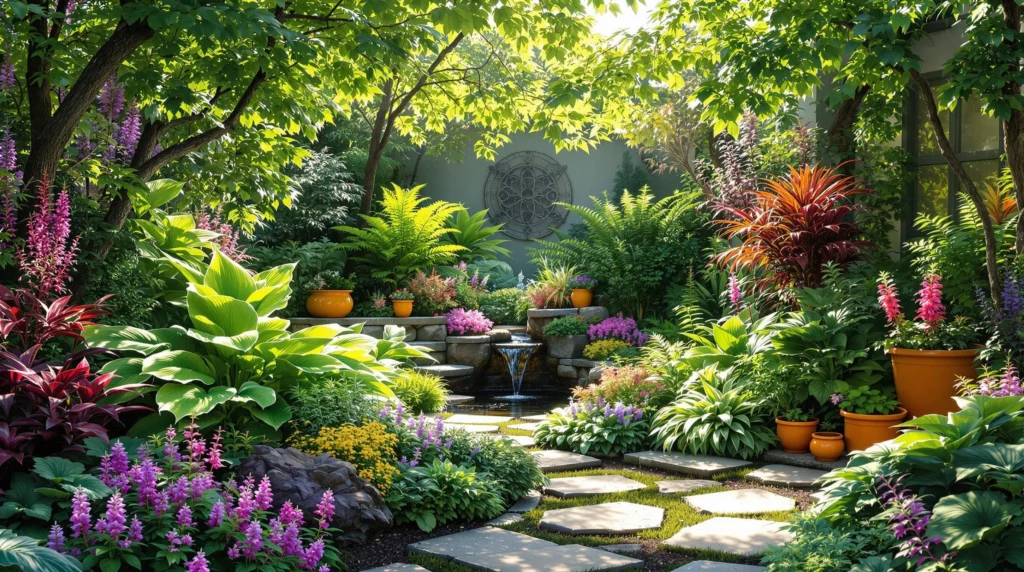10 Stunning Shade-Loving Plants for a Colorful Garden
- Hostas showcase impressive foliage in shades ranging from blue-green to gold and cream-variegated. These versatile perennials come in over 3,000 varieties, with sizes from tiny 4-inch specimens to massive 4-foot giants. They’ll provide season-long interest with their architectural leaves and subtle summer blooms.
- Astilbes bring dramatic plumes of feathery flowers in vibrant pinks, reds, and whites that rise above fern-like foliage. These reliable bloomers thrive in moist, shady spots and create vertical interest from early to mid-summer, reaching heights of 1-3 feet depending on the variety.
- Heucheras (Coral Bells) offer stunning foliage in a rainbow of colors including purple, amber, lime green, and silver. Their year-round color works perfectly as groundcover or container specimens, while delicate flower stalks attract hummingbirds during their summer bloom period.
- Japanese Forest Grass (Hakonechloa macra) creates a cascading waterfall effect with its arching golden or variegated foliage. This elegant ornamental grass brightens deep shade areas and provides movement when catching the slightest breeze, growing 12-18 inches tall and wide.
- Bleeding Heart (Dicentra) produces uniquely shaped heart-pendant flowers in spring on arching stems. The classic variety offers pink hearts with white tips, while newer cultivars come in pure white or deep red, creating romantic charm in woodland garden settings.
- Hellebores (Lenten Rose) bloom incredibly early—sometimes even through snow—with nodding, cup-shaped flowers in shades of white, pink, purple, and speckled combinations. Their leathery evergreen foliage provides structure even after the long-lasting flowers fade.
- Tiarella (Foamflower) creates a frothy display of delicate white or pink flower spikes above maple-shaped leaves that often feature dramatic central markings. These native woodland plants spread gently to form beautiful ground covers in dappled shade areas.
- Brunnera offers heart-shaped leaves often splashed with silver patterns that illuminate dark corners. ‘Jack Frost’ and ‘Alexander’s Great’ varieties create especially dramatic silver foliage effects, complemented by sprays of tiny blue forget-me-not flowers in spring.
- Japanese Painted Ferns combine silver, burgundy, and green fronds in a stunning display that looks almost hand-painted. These easy-care perennials maintain their striking coloration throughout the growing season and mix beautifully with other shade lovers.
- Ligularia makes a bold statement with large, toothed leaves in deep green or purple-black and tall spikes of daisy-like yellow flowers. Varieties like ‘Rocket’ can reach 4-5 feet tall, creating dramatic vertical accents in moist shade gardens where few other plants make such an impact.
Creating Contrast with Variegated Foliage in Shady Spots
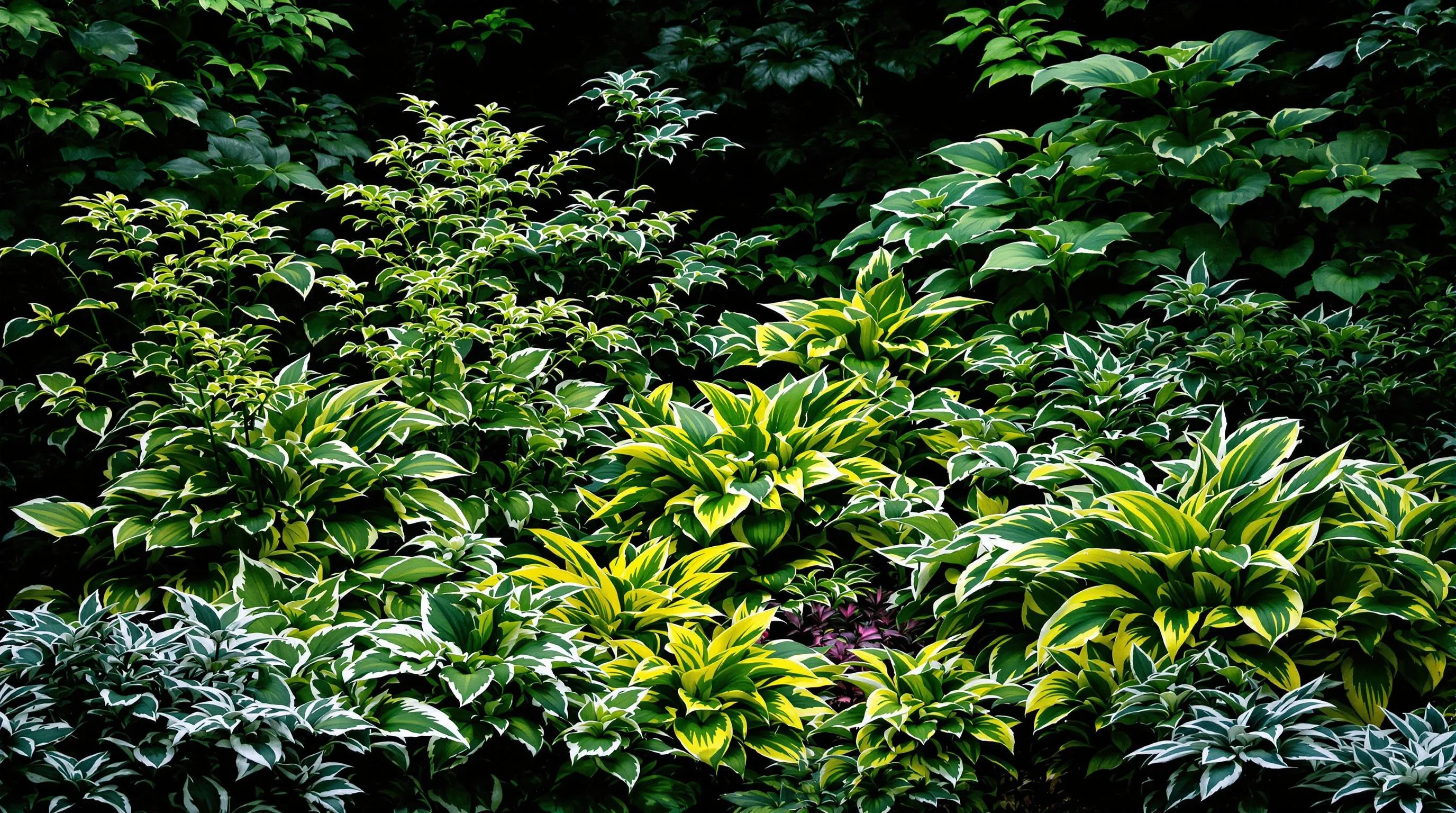
Variegated foliage acts as nature’s spotlight in shadowy garden corners, bringing visual interest through leaves streaked, splashed, or edged with contrasting colors. These plants create depth and dimension, effectively brightening areas where flowering plants might struggle.
Best Variegated Plants for Deep Shade
Hostas reign supreme in the variegated shade garden, with ‘Patriot’ showcasing crisp white edges against deep green centers and ‘Frances Williams’ offering blue-green leaves with chartreuse margins. Japanese Forest Grass ‘Aureola’ thrives in shade, displaying bright gold stripes that seem to glow in dim light. Brunnera ‘Jack Frost’ features silver-frosted leaves with green veining that creates an intricate lace pattern. For ground cover, consider Lamium ‘White Nancy’ with silvery-white centers and green edges that brighten dark corners. Pulmonaria ‘Majeste’ offers silver leaves that reflect even minimal light, while Variegated Solomon’s Seal produces arching stems with white-edged leaves and dangling white flowers. These plants maintain their striking appearance even without direct sunlight, providing year-round interest where other plants falter.
Designing with Light-Reflecting Leaves
Strategic placement of variegated plants can transform your shade garden through their light-reflecting qualities. Position silver or white-variegated specimens at the back of borders where they’ll catch and bounce limited light forward. Create visual pathways by placing variegated plants along garden edges where they’ll naturally draw the eye through the industry. For maximum impact, group varieties with similar variegation patterns together to form cohesive “bright spots” rather than scattering them throughout. Complement these light-catchers with solid dark green foliage to create depth and make the variegation pop even more dramatically. During evening hours, white-variegated plants take on an almost luminous quality, extending your garden’s visual appeal beyond daylight hours and creating magical moonlight gardens in deeply shaded areas.
Incorporating Bright Containers and Garden Art
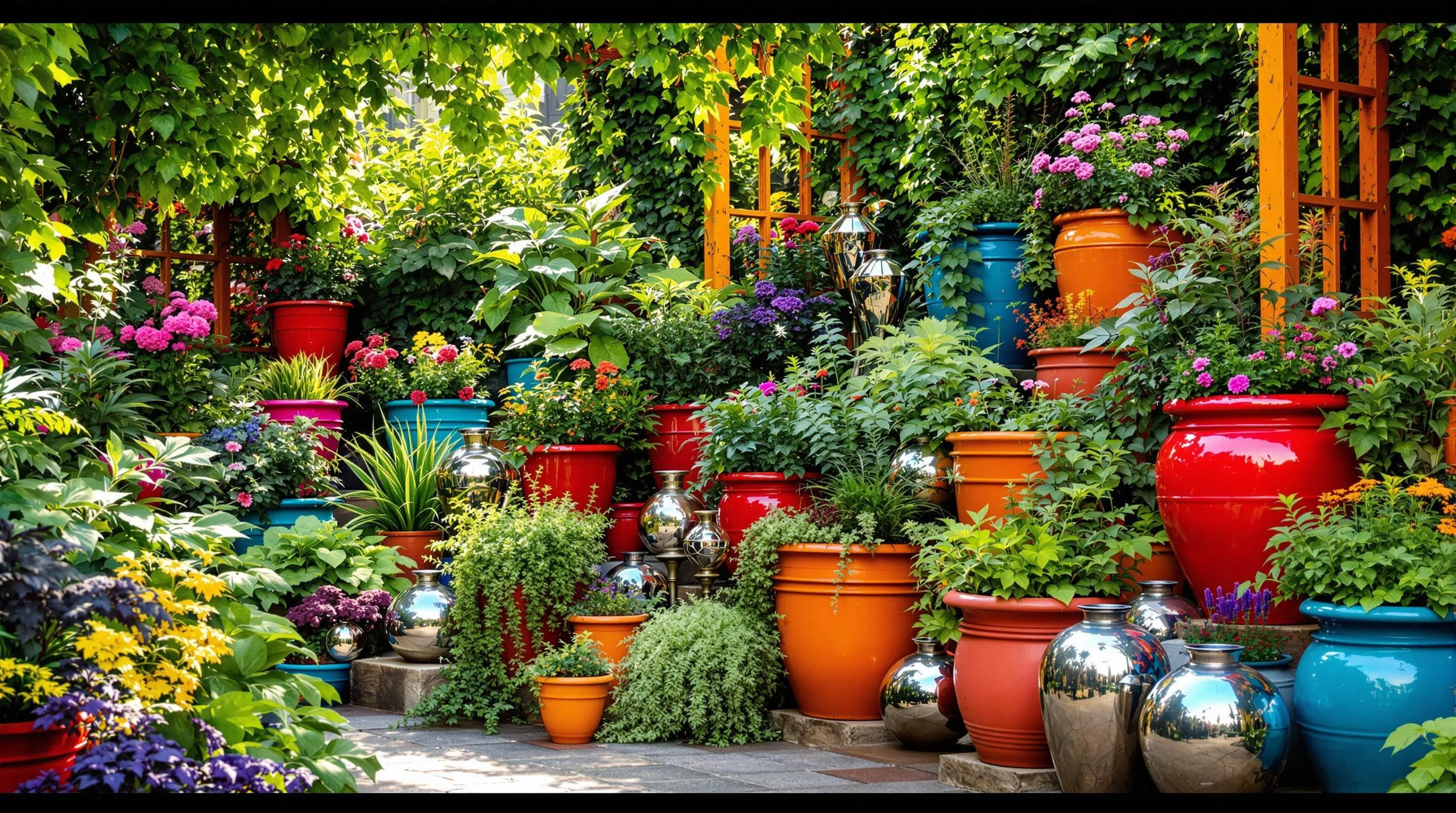
Transform your shade garden from mundane to magnificent by adding vibrant containers and artistic elements. These non-plant additions create instant color and visual interest even when flowering options are limited in low-light areas.
Colorful Pot Arrangements for Shade Gardens
Bright containers offer an immediate color boost to shady corners where flowers might struggle. Select pots in bold reds, vivid oranges, cobalt blues, or sunny yellows to create striking focal points against the green backdrop of shade plants. Arrange containers in varying heights and sizes for a ever-changing display—try placing larger pots at the back with smaller ones cascading forward. Group complementary colors together, such as purple and yellow or blue and orange, for maximum visual impact. Weather-resistant ceramic, fiberglass, or composite containers maintain their vibrant appearance longer than those made from materials that fade quickly. For added dimension, incorporate hanging baskets with trailing plants like fuchsia or begonias to draw the eye upward and create a multi-level garden experience.
Using Mirrors and Reflective Elements
Strategic placement of mirrors can revolutionize your shade garden by bouncing available light into darker corners. Position weather-resistant mirrors to reflect both light and attractive garden views, creating the illusion of expanded space. Beyond traditional mirrors, incorporate metallic garden ornaments like copper wind spinners, stainless steel gazing balls, or silver garden stakes that capture and scatter light throughout your shade garden. Glass garden orbs in various colors add sparkle while creating miniature light shows when the sun breaks through. For safety, secure all reflective elements firmly and position them to avoid blinding reflections toward seating areas or neighboring properties. These reflective additions not only brighten your garden visually but also create an enchanting atmosphere as they interact with shifting light patterns throughout the day.
Layering Textures for Visual Interest in Low-Light Areas
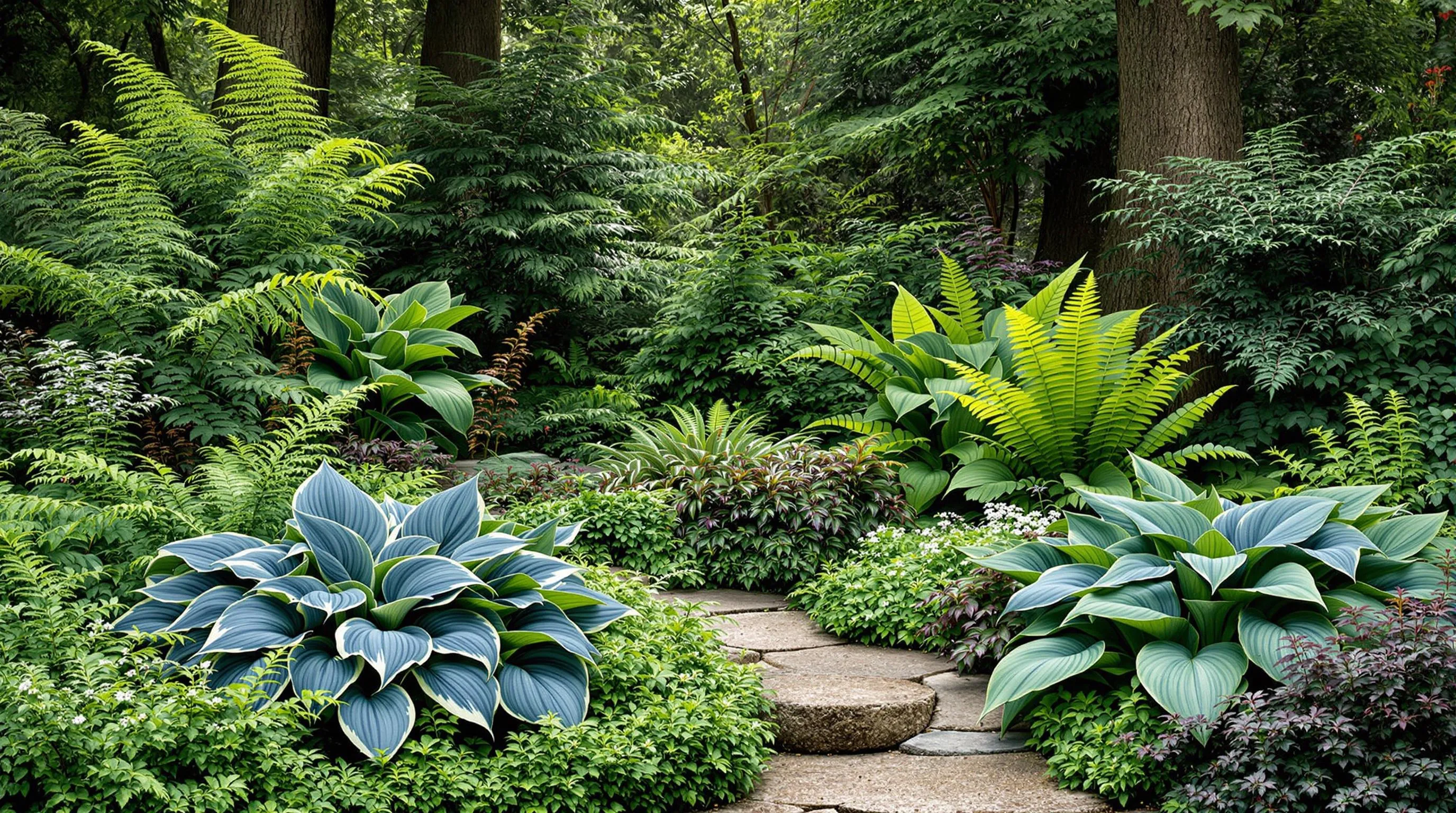
Shade gardens offer the perfect opportunity to experiment with textural contrast rather than relying solely on flowers for visual appeal. Creating depth and dimension through thoughtful layering can transform a flat, uninspiring shaded area into a rich tapestry of plant life that captivates the eye even without bright blooms.
Combining Different Leaf Shapes and Sizes
Textural diversity is your secret weapon in shade garden design. Pair the bold, corrugated leaves of ‘Blue Angel’ hostas with the delicate fronds of Japanese painted ferns for immediate contrast. Add the round, coin-shaped leaves of Creeping Jenny to soften edges, while incorporating the heart-shaped foliage of wild ginger for a different silhouette. The glossy finish of Bergenia leaves can reflect what little light enters your shade garden, creating a striking contrast against the matte texture of coral bells. Try grouping plants in odd numbers (3, 5, or 7) of different textures for the most natural-looking arrangements. This strategic combination of coarse, medium, and fine textures creates visual rhythm that draws visitors through your garden, captivating their sense of touch as much as sight.
Adding Height Variation to Shade Gardens
Strategic height layering creates essential vertical interest in shade gardens where flowering displays might be limited. Start with ground-hugging plants like sweet woodruff or ajuga as living mulch, then add mid-height performers such as heucheras and hellebores. For the back layer, incorporate taller shade-tolerant shrubs like oakleaf hydrangea or the architectural stems of Japanese forest grass. Tall ferns like ostrich ferns (reaching 5-6 feet) can create dramatic backdrops, while shade-loving climbing plants such as climbing hydrangea can use vertical spaces on trees or structures. This multi-tiered approach prevents your shade garden from appearing flat and one-dimensional, instead creating a rich, forest-like environment with multiple points of visual interest. Position taller specimens thoughtfully to avoid blocking what filtered light is available to shorter plants beneath them.
Creative Hardscaping Ideas for Shaded Garden Spaces
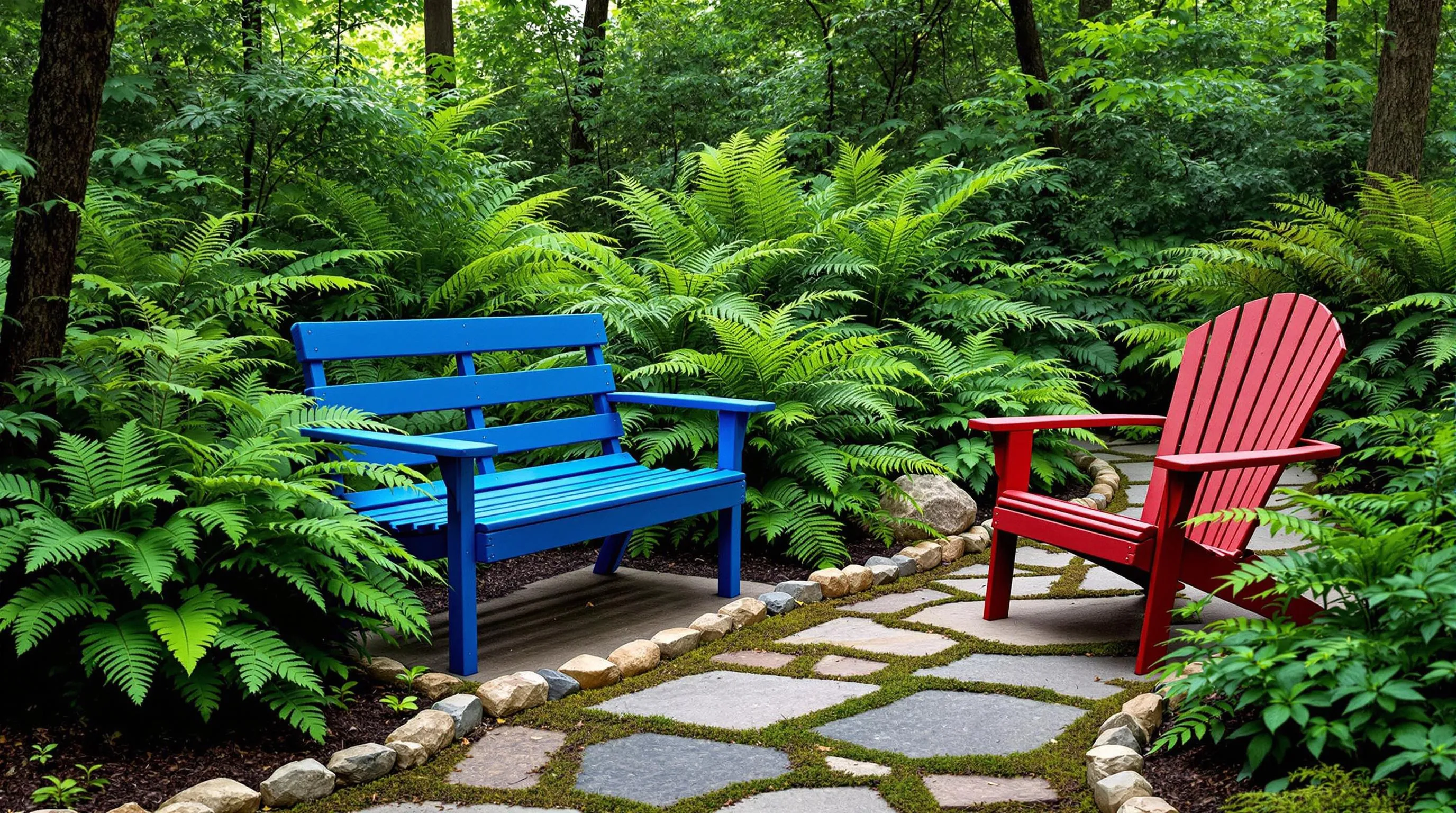
Hardscaping elements provide structure and year-round interest in shady gardens where plants alone might struggle to create impact. These permanent features can transform your shade garden from ordinary to extraordinary, adding functionality while complementing your carefully selected shade-loving plants.
Painted Garden Furniture for Color Pops
Brighten your shade garden instantly with painted furniture in vibrant hues. A cobalt blue bench or cherry red Adirondack chair creates a focal point that stands out dramatically against the verdant backdrop of ferns and hostas. Weather-resistant paints specially formulated for outdoor use ensure your colorful additions remain vibrant for years. Position these pieces strategically—perhaps at the end of a pathway or nestled among woodland plants—to draw the eye through the garden. For a cohesive look, choose colors that complement your existing container plantings or echo the hues in variegated foliage. Even in the deepest shade, these painted elements maintain their visual impact when flowers might be sparse.
Decorative Pathways and Borders
Transform your shade garden’s functionality and aesthetic appeal with thoughtfully designed pathways and borders. Flagstone paths with moss-filled crevices create a woodland feel while providing practical access to all areas of your garden. For a more whimsical approach, try a stepping stone path interspersed with shade-tolerant ground covers like sweet woodruff or ajuga. Edge your pathways with decorative borders using materials that stand out in low light—copper edging develops a beautiful patina over time, while light-colored stone or concrete pavers help define spaces even at dusk. For natural areas, consider log rounds partially embedded in the soil or river rock borders that channel rainfall away from sensitive plants. These hardscaping elements not only solve practical gardening challenges but also add year-round structure when deciduous plants go dormant.
Seasonal Color Planning for Year-Round Interest
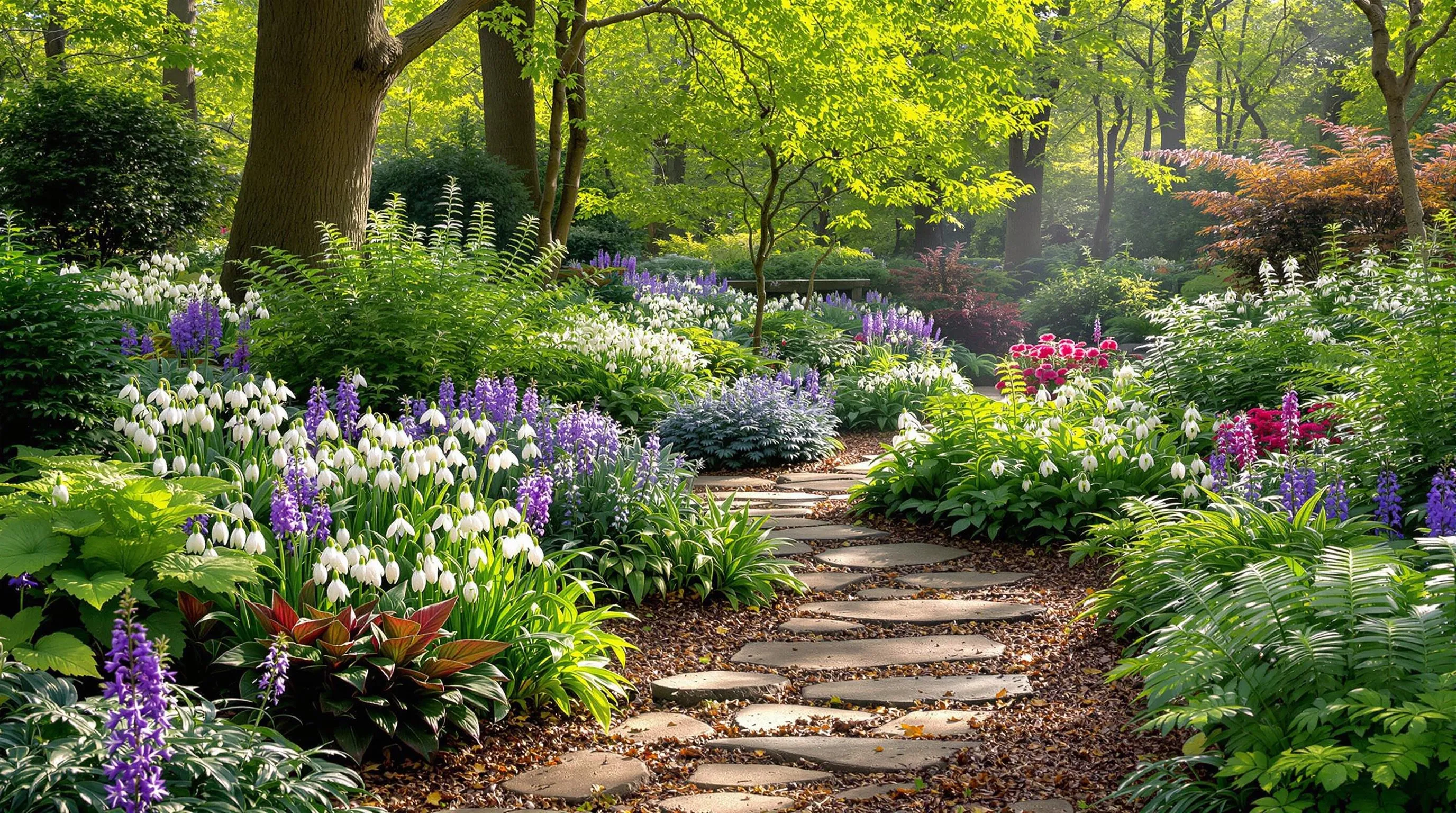
Creating a shade garden that remains vibrant throughout all seasons requires thoughtful planning and strategic plant selection. By incorporating plants with different bloom times and seasonal interest features, you’ll enjoy a ever-changing industry that offers visual excitement in every month of the year.
Spring Bulbs for Early Shade Garden Color
Early spring bulbs can transform your shade garden when most other plants are still dormant. Plant snowdrops, glory-of-the-snow, and Siberian squill in fall for delightful late-winter to early spring blooms before trees leaf out. Spanish bluebells and wood anemones thrive in dappled shade, creating carpets of color in April and May. For reliable performers, try species tulips like Tulipa tarda or T. clusiana, which naturalize well in partially shaded areas. Combine spring bulbs with emerging hostas and ferns for textural contrast during this transitional season. Plant bulbs in clusters of 7-12 for maximum visual impact, and remember to add a layer of leaf mulch after planting to regulate soil temperature and retain moisture.
Fall and Winter Shade Garden Strategies
Extend your shade garden’s beauty into fall and winter with plants that offer late-season interest. Japanese maples provide spectacular autumn foliage before gracefully revealing their architectural branch structure in winter. Incorporate evergreen ferns like Christmas fern and autumn fern that maintain their presence year-round, with autumn fern developing coppery-red new growth in fall. Hellebores deliver winter blooms in shady spots, often flowering from December through early spring. For dramatic winter berries, plant winterberry holly in moister shade areas—the female plants produce bright red berries that persist long after leaves drop. Consider adding witch hazel for its fragrant late-winter blooms and toad lilies for unique fall flowers. Strategic lighting can highlight interesting bark textures and evergreen plantings during winter’s shorter days, while decorative elements like frost-resistant containers and ornamental stakes maintain visual structure when perennials have died back.
Water Features to Enhance Shade Garden Ambiance
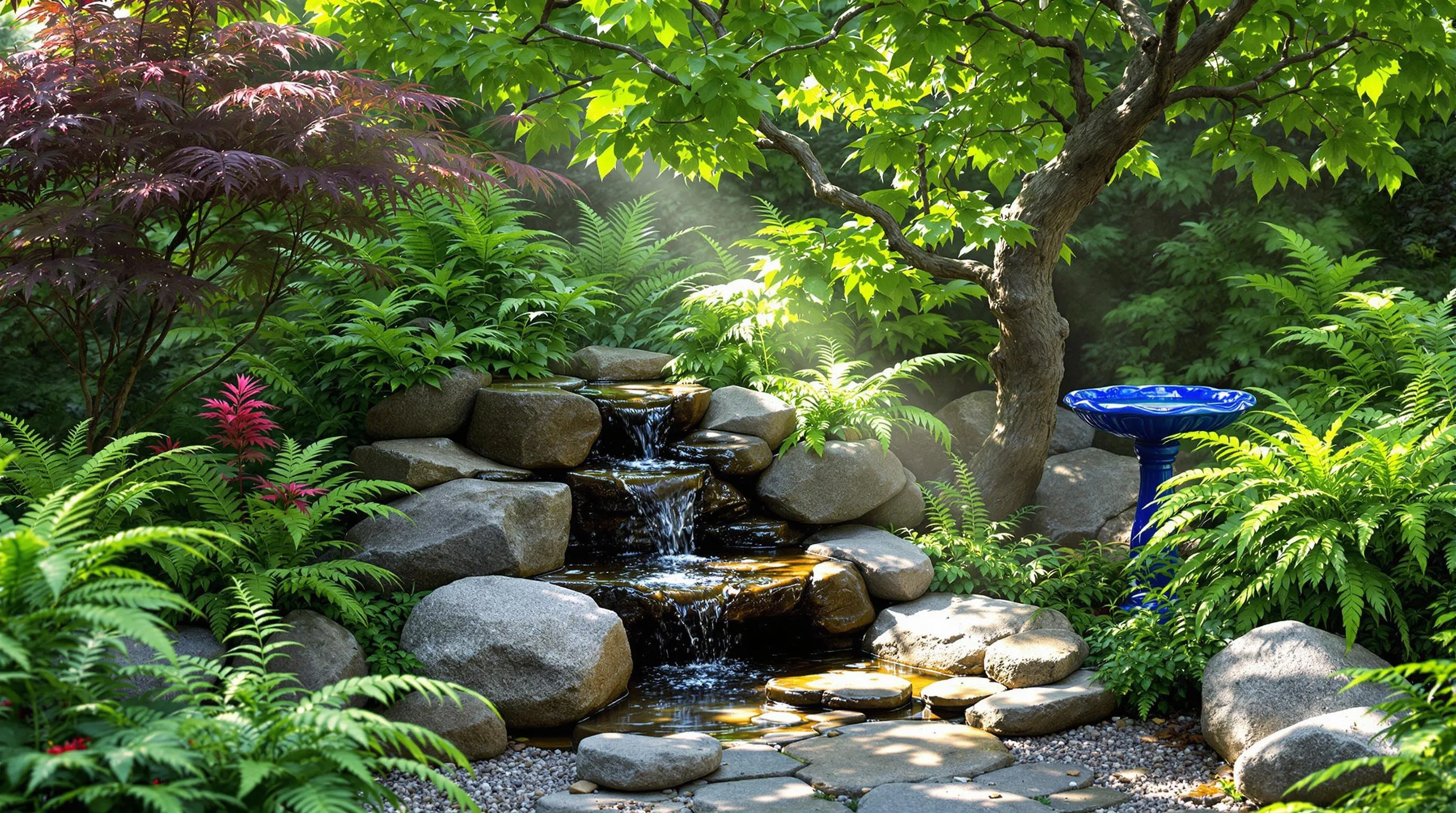
Water features add a sensory dimension to shade gardens, bringing movement, sound, and reflective qualities that transform the space. These elements create a cooling effect that perfectly complements the already refreshing nature of shaded areas.
Small Fountains and Birdbaths for Shady Corners
Small fountains are perfect additions to shade gardens, creating gentle ambient sounds that mask urban noise while attracting wildlife. Position a compact bubbling rock fountain beneath Japanese maples or nestled among ferns to establish a tranquil focal point. Self-contained fountains require minimal installation—simply add water and plug in—making them ideal for gardeners of all skill levels. For deeper shade, choose fountains with integrated lighting to illuminate water droplets after sunset, extending your garden’s enjoyment into evening hours.
Birdbaths offer both practical wildlife support and aesthetic appeal in shaded areas. Select models with textured surfaces where birds can grip securely, and place them at varying heights throughout your garden. Ceramic birdbaths in cobalt blue or emerald green provide striking color contrast against the predominantly green backdrop of shade plants. Position these water features where you can easily observe visiting birds from a window or seating area, creating your personal nature retreat.
Creating Reflective Surfaces with Water Elements
Water’s reflective quality dramatically enhances shade gardens by capturing and multiplying available light. Small ponds lined with dark material create mirror-like surfaces that reflect overhead tree canopies and sky glimpses, visually expanding your garden’s dimensions. Edge these water features with moisture-loving plants like Japanese iris and cardinal flower for a seamless integration with your shade garden palette.
For smaller spaces, consider glazed ceramic water bowls placed strategically to catch dappled sunlight. These simple water elements reflect movement from surrounding plants while providing drinking sources for beneficial insects and birds. Enhanced with floating plants like miniature water lilies or water lettuce, these reflective surfaces add layered interest while maintaining the cool, contemplative atmosphere that makes shade gardens so appealing. For evening ambiance, float candles or solar-powered lights on larger water features to create magical reflections that illuminate the surrounding plantings.
Lighting Solutions to Brighten Dark Garden Areas
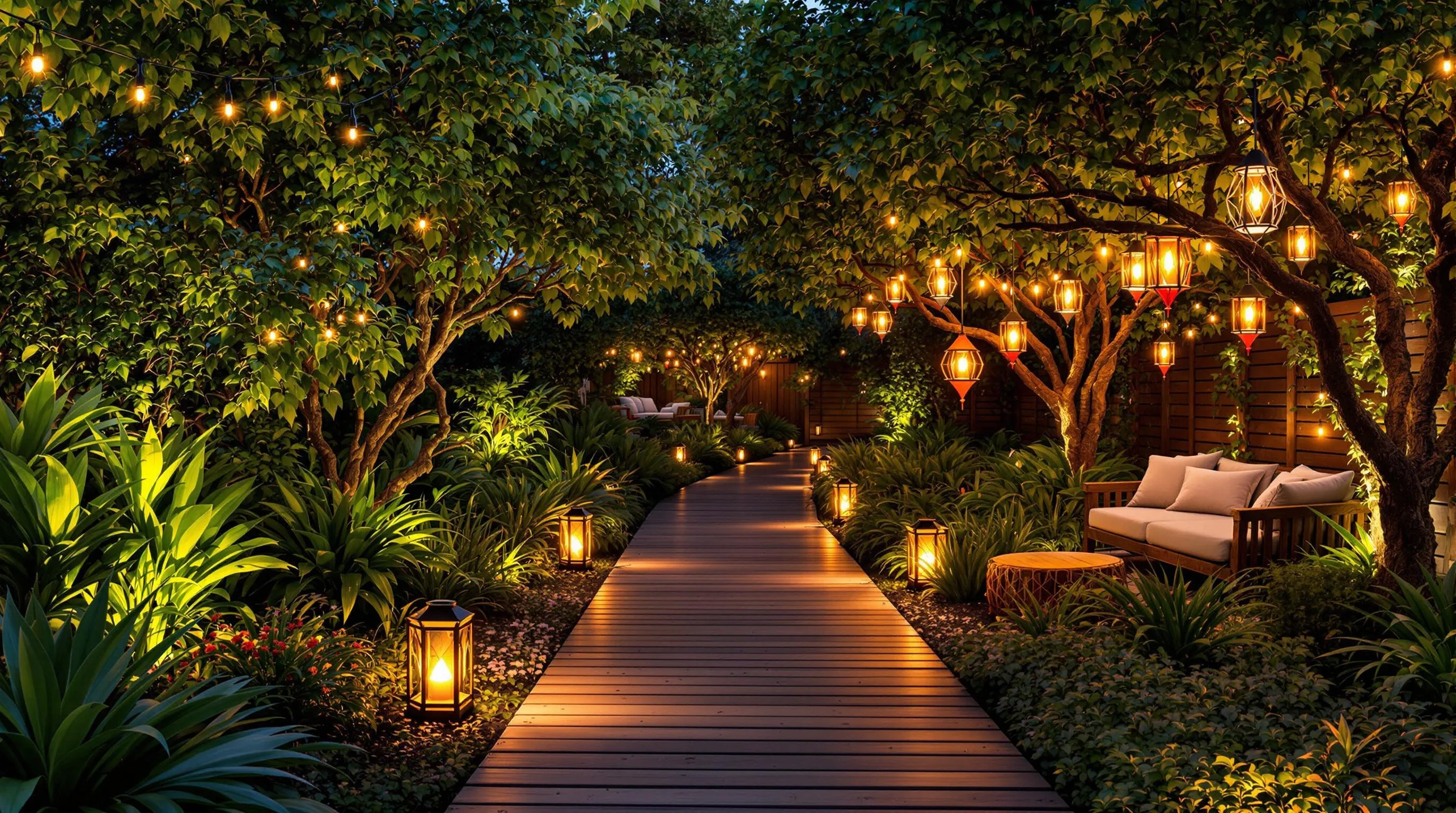
Even the most beautifully designed shade garden can benefit from strategic lighting to enhance its appeal, especially during evening hours or in particularly dark corners. The right lighting answers can transform your shade garden from a daytime retreat into a magical nighttime oasis.
Solar Options for Eco-Friendly Garden Illumination
Solar lighting offers a sustainable way to illuminate your shade garden without increasing your energy bills or requiring complex wiring installations. Today’s solar lights come in many styles that can enhance your garden’s aesthetic while providing practical illumination. Path lights with stakes can define walkways and borders, while decorative solar lanterns can be hung from tree branches to create pools of gentle light. For maximum efficiency, position solar panels in spots that receive at least some direct sunlight during the day—many modern solar lights feature detachable panels that can be placed in sunnier locations while the lights themselves remain in shaded areas. Solar-powered fairy lights draped through shrubs or wrapped around tree trunks add a whimsical glow that can highlight your shade-loving plants’ unique textures after sunset.
String Lights and Lanterns for Evening Enjoyment
Transform your shade garden into an enchanting evening retreat with strategically placed string lights and lanterns. Weather-resistant LED string lights woven through tree branches or draped along fences create a canopy of twinkling illumination that’s both practical and atmospheric. Battery-operated lanterns placed among plantings offer portable light sources that can be moved as needed for gatherings or garden activities. Consider vintage-style Edison bulb strings for a warm, golden glow that complements the cool tones of most shade gardens. For a distinctive touch, try color-changing LED lights that can be adjusted to match seasonal plantings or set a exact mood. Pendant lights hung from sturdy tree limbs can provide focused lighting for seating areas, allowing you to enjoy your shade garden well into the evening hours. These lighting options not only extend your garden’s usability but also highlight the textural beauty of shade-loving plants when natural light has faded.
Low-Maintenance Shade Garden Design Tips
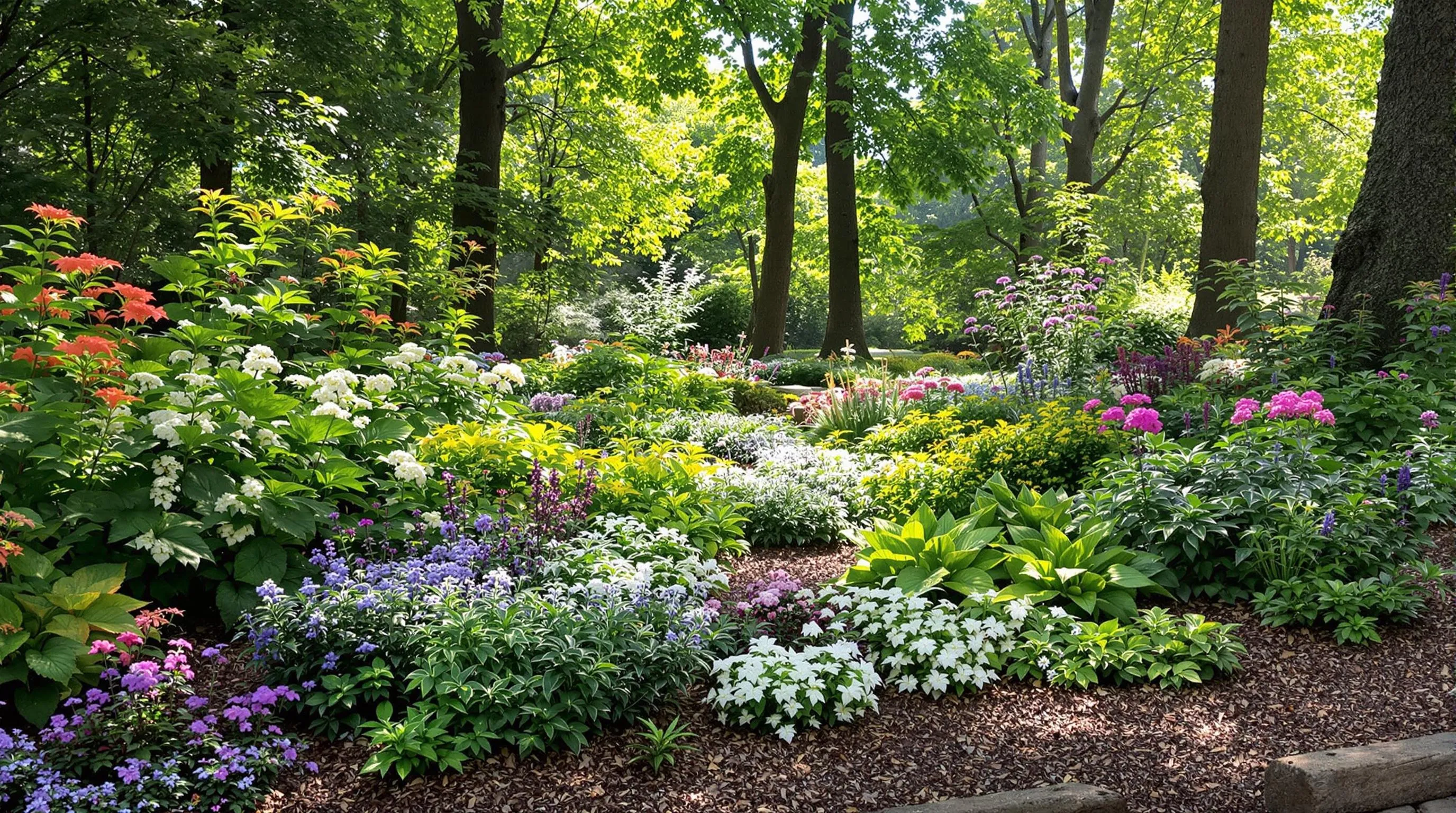
Creating a beautiful shade garden doesn’t have to mean endless hours of maintenance. With smart planning and proper plant selection, you can enjoy a vibrant retreat that practically takes care of itself.
Ground Cover Options for Problem Areas
Ground covers offer perfect answers for challenging shady spots while minimizing weeding and maintenance. Sweet woodruff creates a fragrant carpet of star-shaped white flowers and whorled leaves that thrives in dry shade beneath trees. Pachysandra forms a dense, evergreen mat that’s virtually indestructible, making it ideal for areas where grass won’t grow. For moist, woodland conditions, try wild ginger with its glossy, heart-shaped leaves that effectively crowd out weeds. Ajuga (bugleweed) offers colorful foliage in purple, bronze, or variegated patterns plus spring flower spikes that attract pollinators. In areas with dappled light, Canadian wild ginger, foamflower, and creeping Jenny will spread gradually to fill bare spots without becoming invasive. Plant ground covers in groups of three or five for quicker coverage, and water regularly during the first season to establish strong root systems.
Mulching Techniques for Healthier Shade Plants
Proper mulching dramatically reduces maintenance while improving plant health in shade gardens. Apply a 2-3 inch layer of shredded leaves, pine straw, or bark mulch to retain moisture, suppress weeds, and gradually add organic matter to the soil. Keep mulch pulled back 1-2 inches from plant stems and tree trunks to prevent rot and pest problems. Pine needle mulch works exceptionally well for acid-loving shade plants like azaleas and rhododendrons, while leaf mold creates a natural woodland feel that mimics the forest floor. For areas with heavy shade, consider using a lighter-colored mulch like pine bark to brighten the space visually. Refresh your mulch annually in spring, but avoid creating layers deeper than 4 inches which can prevent water from reaching plant roots. Composted mulch breaks down faster but adds valuable nutrients that feed your shade plants throughout the growing season, reducing the need for additional fertilization.
Edible Options for Shade Gardens
Your shade garden doesn’t have to be just about beauty—it can nourish you too! Many edible plants thrive in partial shade including leafy greens like arugula kale and Swiss chard. Herbs such as mint parsley and cilantro actually prefer cooler spots protected from harsh afternoon sun.
Berry lovers will be delighted to know that woodland natives like blueberries and elderberries can produce delicious harvests in dappled light. For an Asian-inspired touch try growing shiitake mushrooms on logs tucked beneath tall perennials or shrubs.
By integrating these edibles with your ornamental shade plants you’ll create a garden that’s not just a feast for the eyes but for your table too. With thoughtful planning your once-overlooked shady spaces can become the most productive and beautiful areas in your industry.

